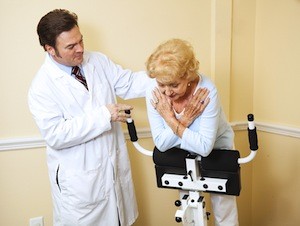
People with degenerative disc disease may automatically assume they will need surgery to correct the problem. However, in many instances, physical therapy can prevent pain and reduce the occurrence of future flare-ups. If your doctor recommends this course of action, here are some of the exercises you will likely be asked to perform on a regular basis.
Stretching for Degenerative Disc Disease
Your spinal column, as well as the ligaments, muscles and tendons in your back, are designed to move. If you are experiencing any sort of limitations in your range of motion, that can lead to back pain. Physical therapy for degenerative disc disease could involve weeks or even months of stretching exercises to increase that range of motion. Many people find that stretching brings them sustained relief from discomfort.
Hamstring stretches can also be effective. There is a well-established link between tightness in the hamstrings and lower back pain, although researchers are not sure exactly how the connection works. It is known, however, that hamstring tightness leads to limited pelvic motion, which can then place stress on the lower back. By stretching your hamstrings regularly, you may be able to reduce back pain significantly.
Strengthening Exercises for Degenerative Disc Disease
The stronger the muscles that surround the spine, the less pain you will likely feel due to degenerative disc disease. Your physical therapist may focus on exercises that will strengthen your lumbar area – especially if you are experiencing pain associated with the sciatic nerve. In addition, low-impact aerobic exercises such as aquatic therapy, exercise biking or walking on a treadmill can also reduce pain.
The professionals with Advanced Spine & Orthopedics will always recommend the most conservative treatment option for degenerative disc disease. However, if this method proves ineffective, we may still be able to fix your issue through a minimally invasive surgical procedure. To schedule an appointment or learn more about the services we offer, contact us online or call 817-310-8783.

